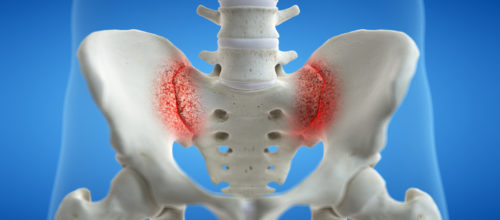
Is Your SI Joint Causing Your Low Back Pain?
The SI, or sacroiliac joint, is the connection between your hip bones and your sacrum. It is primarily responsible for shock absorption and weight transfer between your legs and torso. Dysfunction in the SI joint can mimic other conditions such as sciatica, stenosis, or lumbar disc herniation, so it is important to get an accurate diagnosis. It is estimated that the SI joint is the source of pain in 15-30% of patients with low back pain.
Symptoms of SI dysfunction can include:
- Pain in the low back or buttocks
- Radiating pain into the leg or groin
- Tingling/numbness in the leg
Symptoms are usually aggravated by standing, walking, negotiating stairs, lying on the affected side, and going from sitting to standing.
The two main categories of SI dysfunction are hypermobility (too much movement) and hypomobility (too little movement). Hypermobility can cause the patient to feel unstable, while hypombility can cause stiffness and muscle tension.
Factors that can contribute to the development of SI dysfunction include:
- Arthritis – like other joints in the body, the SI joints contain cartilage and fluid to aid in movement. Arthritis of the SI joint can cause inflammation and/or loss of motion in the area and lead to dysfunction.
- Injury/surgery to the lumbar spine or hip –traumatic injuries, fusions, and joint replacements have been found to place abnormal stress on the SI joints.
- Pregnancy – during pregnancy your ligaments will stretch to allow your pelvis to widen. This, along with pregnancy related weight gain, can increase stress on and cause inflammation of the SI joints.
- Uneven leg length: Sacroiliac joint pain can be triggered when one leg is weaker or longer than the other, which creates uneven movement and stress in the pelvis.
For most patients, conservative treatment, including physical therapy, is effective in relieving the pain and restoring the motion deficits associated with sacroiliac joint dysfunction. If you are experiencing low back or leg pain and SI dysfunction is suspected, our therapists will conduct a series of tests to rule in/out the SI joint as a source of your symptoms.
Examples of hip and pelvic exercises that may be incorporated into a SI dysfunction treatment plan include:
STRETCHING (hamstrings, hip flexors, piriformis)
STRENGTHENING (glutes, hip abductors, hip adductors)
In addition to stretching and strengthening, manual therapy techniques are frequently incorporated as part of the physical therapy treatment plan. Some of these techniques include manipulation, mobilization, and muscle energy techniques (MET), which is an active technique used to help relax/lengthen muscles attached to the SI joint.
References:
https://www.physio-pedia.com/Sacroiliac_Joint_Syndrome
www.hep2go.com






